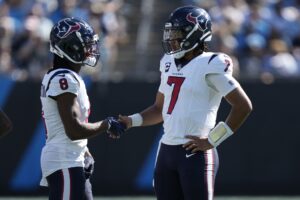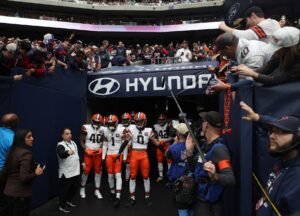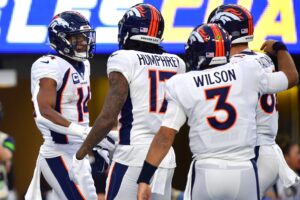How teams choose to use their draft capital is a good way of seeing how competent a front office believes their team is. Both the Chiefs and Texans didn’t believe their current quarterback situation was sufficient to take them from being a playoff team to a Super Bowl Contender. They traded up to snag their potential starter of the future. San Francisco saw themselves as more than one player away and traded back.
David Gettleman has shown remarkably consistent tendencies during his drafts as general manager of the Carolina Panthers. Most notably is his willingness to draft many similar players at positions within the same draft. In 2013, his first draft with Carolina, Gettleman used his first two selections on defensive tackles. His selections of Star Lotulelei and Kawann Short are still on the roster and producing at high levels. In the 2016 draft, he used three consecutive picks on cornerbacks.
The 2017 NFL Draft Will Overhaul the Carolina Panthers Offense
In Carolina, the front office and coaching staff identified one glaring problem. Cam Newton has been extremely inefficient completing short throws. According to NFL Network’s next gen stats, Newton had a significantly worse than average passer rating on throws under ten yards down the field in 2016.
Cam Newton's #NextGenStats passer rating grid from the 2016 season. pic.twitter.com/eqSRi8bT8P
— Matt Harmon (@MattHarmon_BYB) January 16, 2017
This year was yet another example of Gettleman’s philosophy. They found the flaw and addressed it. In selecting Christian McCaffery with the eighth overall pick, the Panthers got a running back that can also line up as a receiver. Subsequently, with the 40th pick, Gettleman took Curtis Samuel, a wide receiver who can also play running back. Both of these additions should help provide Newton with easier throws.
Using Christian McCaffrey‘s Strengths
McCaffrey’s greatest strength is his versatility. He will likely be used in many motion sets, lining up in the shotgun next to Newton, then motioning into the slot, or vise versa. This play from Stanford’s 2016 game against USC is a prime example of how McCaffrey could be used by Mike Shula in Carolina to get Newton easy short throws. Here, McCaffrey motions from the right side, making the defense hesitate – as he would be a threat for a direct snap or sweep – before getting running start into the flat. If Stanford quarterback Ryan Burns would’ve gotten rid of the ball sooner, McCaffrey would have been able to use his shiftiness in space even more.
The Panthers run a lot of heavy set formations from the shotgun, formations rarely used in the NFL outside Carolina and Tennessee. McCaffrey has shown an ability to play both power football, and run from the shotgun at Stanford. Scouts knocked McCaffrey for his size, suggesting he will struggle running between the tackles at NFL level. However, many of the runs in the Carolina offense come from the shotgun, and that will likely increase with McCaffrey in the backfield. Runs like this showcase McCaffrey’s vision and more importantly his strength to run between the tackles. Runs like this will not only help showcase McCaffrey’s ability as a runner, but will take the pass rush off of Newton.
Making the Most of Curtis Samuel’s Ability
McCaffrey and Samuel no doubt have similar traits. Both essentially play the same positions and are multidimensional, playing everywhere from tailback to receiver to kick returner in college. The one thing that separates Samuel is his pure speed. At the combine, Curtis Samuel ran a 4.31 40 yard dash (McCaffrey ran a 4.48). This made him the second fastest receiver (behind John Ross‘ record), and the fastest running back in the draft.
I can see the Panthers using Samuel in a role similar to how Ted Ginn was used in Carolina. He will be the go-to deep threat, and will also likely catch quick screen passes and take sweep handoffs. Whereas McCaffrey is a more capable between the tackles runner, the Panthers will likely use Samuel’s touches in a similar manner to this play at Ohio State.
Samuel will also likely be used in plays similar to McCaffrey, creating quick throws for Cam Newton. Getting Samuel in space will be a prime task for Mike Shula. With his speed, defenders are required to play off of him, creating magnificent cuts for easy throws like this one (even though Barrett missed).
As previously mentioned, Samuel will be a fantastic long-ball threat for the Panthers. He will take the deep shots that Ted Ginn received in 2015 when the offense was firing on all cylinders. In this play, he motions out from the backfield. Yet again, the ability to create confusion will be remarkably available to Carolina moving forward. After motioning, there’s simply no one on Oklahoma’s talented D that can run with him. All it took was one simple inward fake, and the safety had no chance to stay with him to the pylon.
Final Thoughts
Mike Shula is going to have a fun off-season. Any wild ideas locked inside an offensive coordinator’s mind can be released with these two weapons. Any sort of motions, unique formations, and two or three back sets are all in play. Cam Newton’s health is going to play a major factor. After his offseason surgery, Newton is expected to return by training camp. This full and timely recovery will be instrumental in Carolina’s ability to incorporate their new weapons.
Carolina has 148 targets lost from their 2016 roster. There will be ample opportunity for McCaffrey and Samuel to step into this offense and make an impact week one. Mike Shula is facing a remarkable task of finding ways to incorporate these two new ballplayers. Regardless of the usage, this offense will be remarkably fun to watch in 2017.
Gifs courtesy of DraftBreakdown scouting videos






